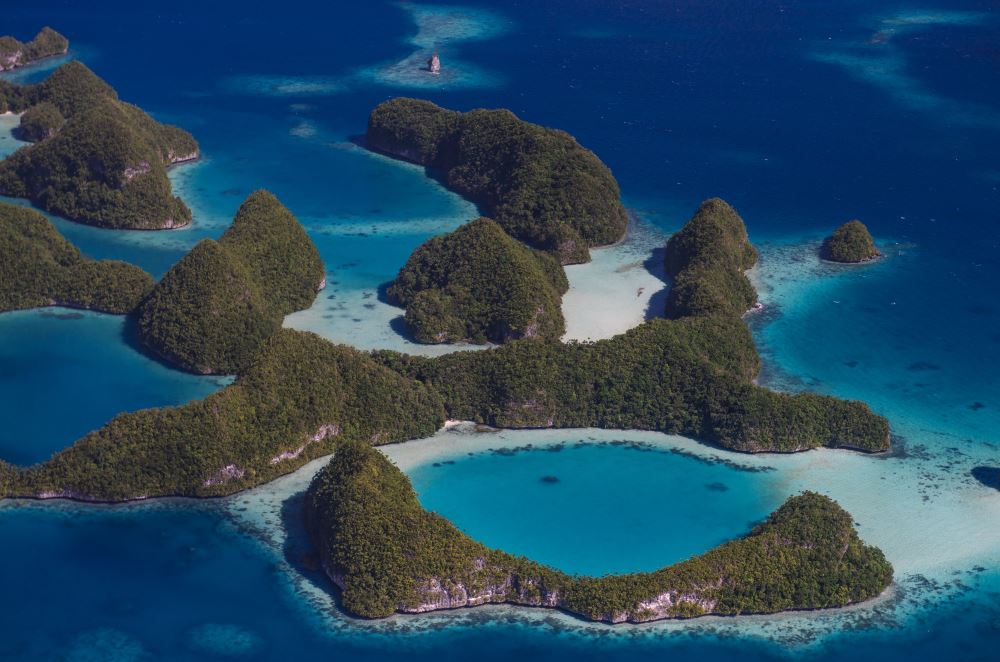 Micronesia is an archipelago of over 2,000 islands and coral atolls located in the Northwest Pacific, between the Equator and the Tropic of Cancer.
Micronesia is an archipelago of over 2,000 islands and coral atolls located in the Northwest Pacific, between the Equator and the Tropic of Cancer.
This includes the Marianne Islands, with Guam and the US Commonwealth of Mariana Island (Saipan, Tinian and Rota), the Carolinas with the Republic of Palau and the Federated States of Micronesia (Yap, Truk, Kosrae, and Pohnpei), the Marshall, Nauru and Kiribati. The islands that form the archipelago of Palau, traditional name Belau, in Micronesia, represent a unique ecosystem, consisting of 700 different coral species, 1,500 species of tropical fish, more than 30 salt lakes, ships and aircraft wrecks to witness conflicts of World War II.
The capital Koror, situated northeast on the homonymous island, is also the economic and administrative center where live 2/3 of the archipelago population.
A world that words find difficult to describe, where the feeling you get follows the path of mangroves: are born from the sea and grow toward the sun. The nature is competing with itself and with the human imagination as to shapes and colors.

You can move around and dive in a unique ecosystem made of two hundred small emeralds, with 700 coral species, 1,500 kinds of tropical fish and more than 30 magical salt lakes.
The most enchanting view of Palau, an intricate maze of islands enclosed in a picturesque Micronesia archipelago, appears from the plane shortly before landing.
The emerald green of the dense forest that covers every square centimeter of any outcropping land shines above the azure and opalescent blue sea.
They are green, still waves. Curves that surround white foam rings and chase them in the vastness of the sea, like a dream that repeats but you cannot identify.

Rock Islands
The Rock Islands are a true wonder of nature. More than 200 of these lumps of limestone covered with jungle dot the waters for a strip of 35 km south of Koror.
Their foundations, having been consumed by the action of tides and from grazing of marine creatures, are narrower than the upper part making them look like emerald-green fungi rising from a turquoise sea. From above they offer a spectacular panorama and it’s worth, if only for the sight, take a flight from Koror to Angaur or Peleliu. Inland, you can find 35 ponds and some islets are surrounded by white beaches as soft as baby powder.
Some of them, the “Seventy Islands”, are protected marine area, where turtles nest undisturbed.
Describing just with words the emotions that these spectacular backdrops offer is not easy: here, reality exceeds any possible imagination. Palau offers to scuba divers and snorkel enthusiasts attractions that cannot be compared to anywhere else in the world.
On the surface, Palau is a constellation of islands covered by dense jungle, floating on the green crystalline waters of the ocean.
Under the surface, appears an incredible world, with its seabed among the most beautiful and unspoiled of the whole Pacific.
Spectacular walls, often beginning a few centimeters below the surface to fall for hundreds and hundreds of meters in depth, provide exciting emotions. These vertical descents are located along the outer edges of the reef and the barrier islands, rich in all forms of life and color such as the giant sea fans jutting out into the blue, as if to imitate the big branches of a tree.
Palau, for its geographical position, is characterized by three current streams that converge in these waters, carrying a variety of fish. Sharks, turtles, barracuda, tuna, eagle rays, manta rays, small colorful fish, lobsters, anemones, sponges, and nudibranchs: everything you want to see underwater, in Palau you may come across.

The beauty of this wonderful destination is that diving is not only vertical walls, but can be diversified. Here, in fact, the diver can dive into simple caves where to admire stalactites and stalagmites, be enchanted by a long, dark descent into the famous “blue holes”, or be fascinated by memories of the past, going to visit one of the about 50 Palau’s wrecks.
Palau has also another special attraction: the brackish lakes. In the Rocks Island of Palau, there are about 30 salt lakes. These are true oceans in miniature, lying in the middle of the jungle.
These lakes are isolated from each other and from the ocean, then each of them generated a unique ecosystem and different from other lakes, with organisms that differ between them.
For example, in a lake lives a certain seaweed and a type of crustacean, in another lake a kind of fish, in another just jellyfish, and so on.
Many lakes do not host some predators, and animals have adapted to this, like the “Mastigias” jellyfish did in the “Jellyfish Lake”.
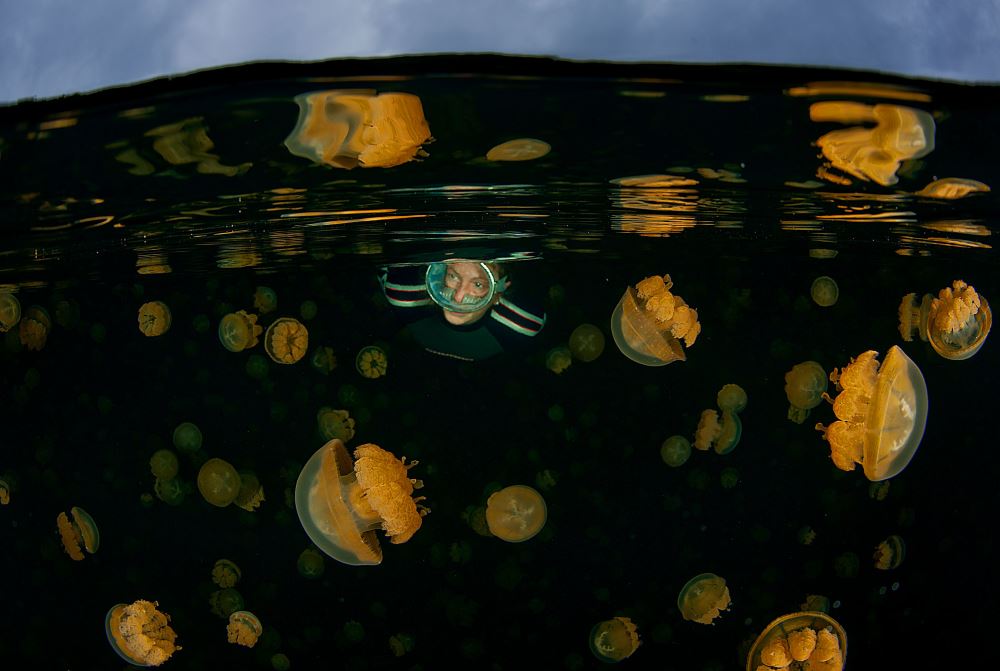
Palau is the kingdom of drift diving, especially at “Blue Corner”.
Nothing to worry about: on the plateau, in fact, are positioned some buoys that the local guides will choose according to the current direction, with ropes where sticking for help during the descent.
The key issue is to remember, whenever instructed during the “briefing” before each dive, that when you jump from the boat you have to do it resolutely, your BCD completely deflated, regulator in your mouth and without pausing at the surface, heading straight down to the bottom by pushing along the rope tied to the aforesaid buoy. Once at the bottom, the current will not give big problems and might even disappear altogether.
However, if you wish to remain still, “anchored” to the bottom in the presence of strong current, it is sufficient to pull out from the BCD’s pocket the “Reef Hook”, a kind of grappling hook provided by the local diving.
An invention of Palauans, which is no other than a steel hook provided with a strong string to hold in your hands. You may fasten it to your jacket through a carabineer so to have both hands free for photographing or filming, yet remaining firmly anchored to the seabed, thus preventing the current from transporting you away.
The reef hook is mandatory for some dives such as Blue Corner, Ulong Channel and Peleliu. You can rent it at the Diving at the price of USD 4 per day.
A personal marker buoy is also mandatory.
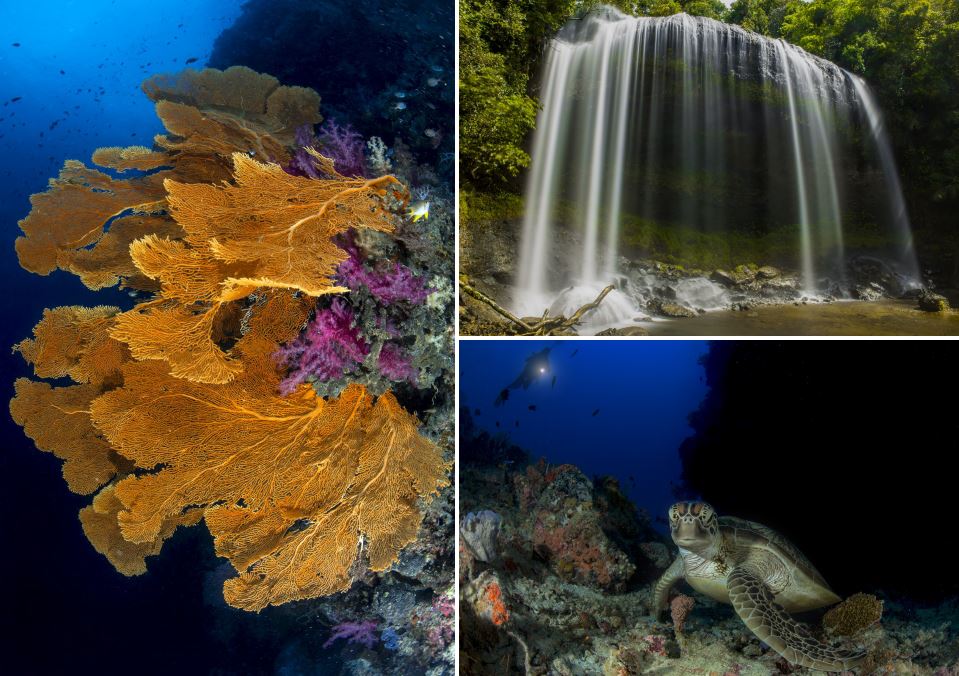
PALAU’S MOST BEAUTIFUL DIVES
Blue Corner
One of the most fascinating dives in the world, which alone is worth the whole trip. Here the ocean current carries many microorganisms, the base of the food chain, pushing them towards the wall. There, as staple of all corals and small reef fish, they become food.
And the small fish are food for larger fish. That’s why the show that appears in the eyes of divers is truly unique: tropical snappers, manta rays, barracudas forming real walls, white tip and gray reef sharks with their pilot fishes swim around undisturbed, along with eagle rays, tunas and Napoleon wrasses.
Even bull sharks and hammerhead sharks have been sometimes spotted here.
The diver, safely anchored with his current hook on the coral plateau at about 25 meters, should simply look in the blue the continuous passage, from side to side of the reef, of these many “lords” of the sea.

Chandelier Cave
A stunning cave despite its simplicity. The access entrance is a big vault just below the surface, at about 5 meters deep. Immediately we are in a large underwater space going down up to about 10 meters.
Going upwards, when you see the water above your head wrinkling, then it will be clear that you are in close proximity to a room located only about 3 meters deep. There you may remove your regulator and breathe the air that, through some micro cracks, filters within the cave. Enlightening the interior of this room with the flashlight, you will give color to the crystal walls and stalagmites in the first room.
Continuing inland, passing through a bottleneck, you will reach another room, far more beautiful than the first. Returning to dive down the flooded cave, you will find another passage that will bring you in a third room where again you could remove your regulator and breathe.
While admiring the room full of stalagmites, the blue of the entrance will always remain visible, offering an incredible emotion!

Virgin Blue Hole
Fantastic dive into a tunnel that starts a few inches below the water surface, among the hard corals in the middle of Ngmelis Reef, between the “Blue Corner” and the “New Drop-off”.
Once arrived at the sandy bottom, you are in a large cave with the exit on the wall at about 30 meters, where it’s easy meeting sleeping whitetip reef sharks and, occasionally, also leopard and nurse sharks.
Generally, the dive continues on the right wall, where the spectacle offered by the soft corals of thousands of colors is unforgettable.
Eagle rays, scorpion fishes, tropical croakers, nudibranchs and many other forms of life, make this dive very interesting for photography lovers.
German Channel
In the early ‘900, German ships used this channel to carry their load of sulfates from the island of Anguar to the port of Koror. Today, divers use the channel to reach the Manta Ray Cleaning Station, the hat of a reef about 20 meters large, where the manta rays regularly pass always looking for plankton and, almost in a kind of circular dance, await that small cleaner fishes free them from parasites. Schools of barracuda are also often present.
Ulong Channel
It’s an exciting drift dive, west of Ulong Island.
The dive begins according to the tides and currents.
Usually, we enter this sandy channel at about 15 meters deep, to exit at its end toward an incredible vertical wall, ending on the sand at 40/50 meters depth, rich in sea fans and colorful soft corals, ideal for photos, where it is easy to find gray sharks resting.
While carried by the current inside the channel, the encounters are amazing: giant clams, turtles, white tip sharks hunting, barracudas, tunas, but the unforgettable show making it a worthwhile experience is given by the long wall on the left side of the channel, full of leaf corals, within which a multitude of fish species live, protected from predators.
As we approach the end of the channel towards the wall, the current increases dramatically, making the diver a slight be at the mercy of nature’s forces.
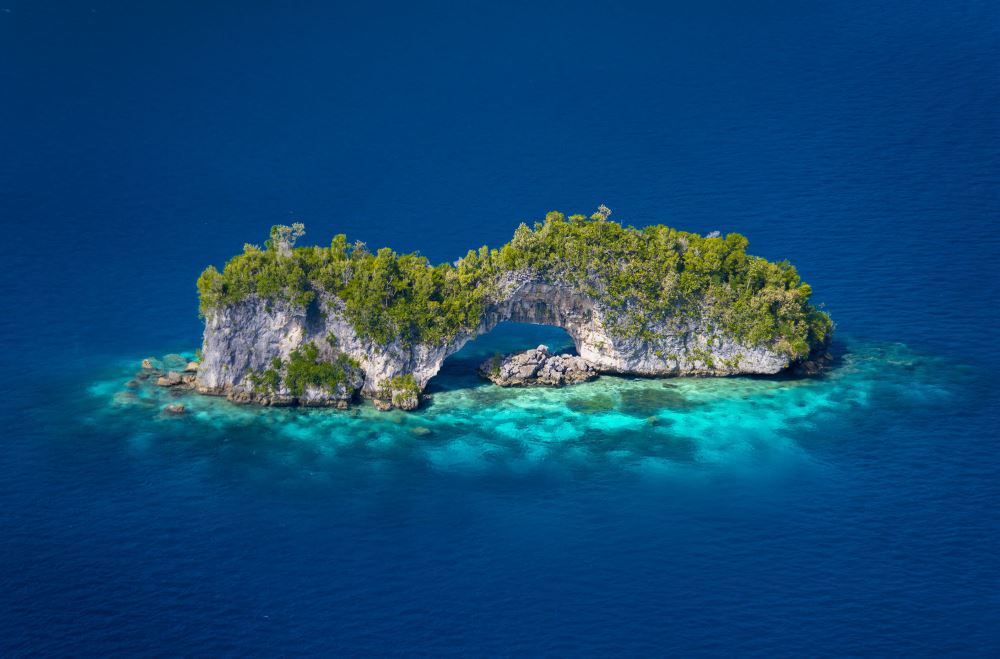
Clam City
It is easy to meet the giant clams while diving in Palau, but the most populated area by these big bivalves is Clam City. Within the lagoon, just off the “70 Islands”, there is a wonderful dive site, only about twenty meters deep. It starts with a white sandy plateau where, at only about six meters deep, we can already meet some clam of gigantic size.
Suddenly, the backdrop becomes steeper and there are tens and dozens of giant clams, close to each other, with different green, turquoise, light brown colors, offering a truly unique show in the world.
Peleliu Corner
Peleliu Corner represents, along with Peleliu Expressway, one of the most challenging dives, but perhaps among the unforgettable ones of Palau. The dive, located on the outside of the Peleliu reef, is reserved only to experienced divers, because here the sea current is really strong.
Surely, during this dive, like at the Peleliu Expressway, divers will have to use their “reef hook” to make it easy to stop on the plateau and watch the show around them, like in an aquarium. Here, the encounter with a multitude of sharks is guaranteed.

Peleliu Expressway
A beautiful dive located at the southern wall of Palau, in open ocean, restricted to the most experienced divers due to the strong current that can sometimes exceed the four knots.
That’s why it is advisable to stay close to your buddy and follow the divemaster’s guidelines since, in case of separation, it would be very difficult being able to get back together.
The dive begins with the wall, rich in thousands of colorful corals, to the right. Encounters with various species of sharks are almost assured and, looking into the blue, you will also see tunas and many other great pelagic species. Continuing to look at the wall while carried by the stream, you’ll meet many parrotfish, small groupers and many other reef species.
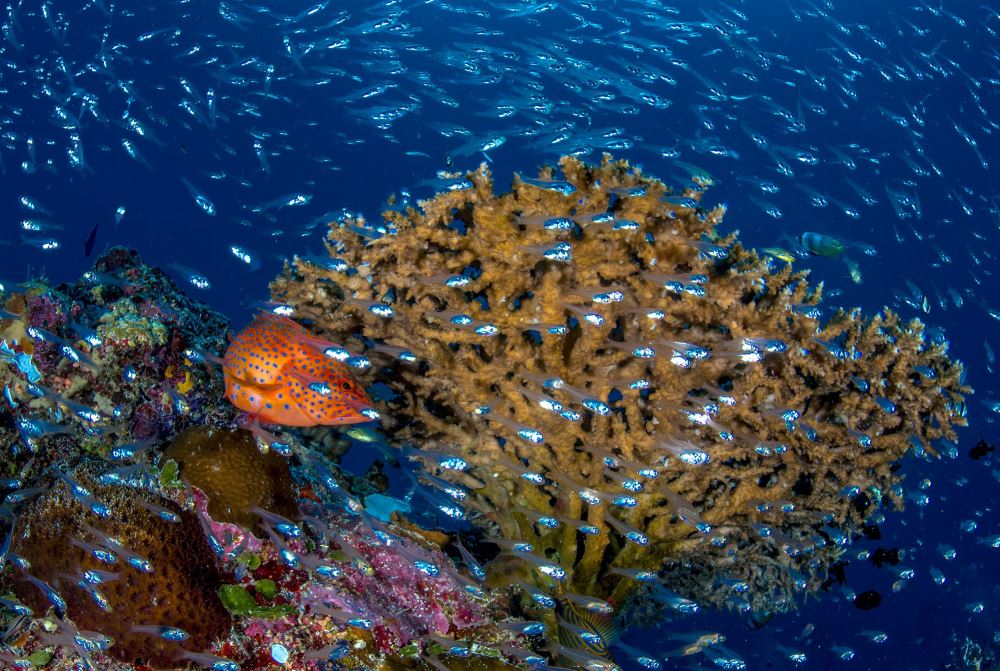
WRECKS OF WORLD WAR II
Before and after World War II, Palau became a strategic Japanese naval base. On March 30 and 31, 1944, the American Navy started an operation called “Desecrate I”, which ended with the sinking of more than 60 ships and planes of the Japanese and American fleets. The wrecks remained unexplored for over 40 years because a local government ban prevented diving. During the last 20 years, it is possible to dive on what are considered real tombs of water and sheets and scuba divers, visiting these sites, can relive the dramatic events of that terrible battle
Iro
Iro is a Japanese tanker, sunk on March 31, 1944, probably by an American submarine traveling from the Philippines to Palau. The ship sank straight and it still is in the sailing position, with its bow about 20 meters deep, while the stern rests on the backdrop at about 40 meters.
The whole ship is covered with soft corals of thousands colors, hard corals and sponges, large oysters, whips and tube corals.
The wreck also offers a safe haven for a variety of fishes: bat and butterfly fishes, box and angelfishes, tropical snappers, and it’s also easy to encounter some small turtles.
Jake Seaplane
Seaplane from the Japanese Navy, sometimes used as a bomber or for “kamikaze” attacks.
The wreck is positioned on a madreporic bottom at 13 meters deep, about a kilometer north of Meyens Island, and is almost intact in all its parts.
Fuselage, propellers, wings, the cockpit, everything seems still working.
Almost as time had stopped, for a moment you almost got the impression that it must rise up in flight at any moment!!!
Around, among the large umbrella-shaped corals, radio parts, bombs, etc. Beautiful dive, easy and without current.
Helmet Wreck
Wreck of a transport ship 58 meters long. The bow is at about 15 meters, while the stern drops to 35 meters deep.
Discovered at the end of the 80’s, it still preserves many evidences of its load: wine bottles, pots, rifles, ammunition, gas masks, and earthenware bottles for saké.
There are still three well-preserved aircraft engines inside the big cargo hold.
Clouds of glassfish inhabit the interior of the wreck, while scorpion fishes, angelfishes, butterfly fishes, tropical groupers and many other species of small fishes surround the ship’s sheets, making the scenario of an unbelievable beauty.
Amatzu Maru
It is a tanker, the largest wreck present in Micronesia, belonging to the Japanese navy fleet.
Many black coral branches and a wide variety of sponges cover the ship, which surroundings are is rich in fish.
It is an excellent wreck for penetrating the internal spaces.
Chuyo Maru
Large Japanese army transport ship, about 100 meters long, sank west of the island of Malakal.
It lies at a depth of 35 meters with the deck, the engine room and the cannon at the stern still intact.
Here, there are many lionfishes, encrusting sponges and large shells. In an upright position, allows divers to penetrating for exploring the interior.
WORDS and PICTURES by Sergio Riccardo

















